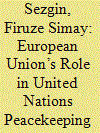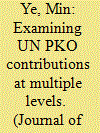| Srl | Item |
| 1 |
ID:
185885


|
|
|
|
|
| Summary/Abstract |
The European Union (EU) repeatedly expresses its support to principles and values of the United Nations (UN), seeing the UN as the core of a rules-based global order. How does the EU perform in contributing personnel to UN peacekeeping operations, and what factors affect their personnel commitments? Recent work shows that the size of the deployed personnel matters for peacekeeping effectiveness, and personnel commitment is a crucial effort by the UN member states to prolong peace. This article’s contribution is to conduct the first analysis on the EU member states’ contribution rates on 53 UN peacekeeping operations throughout the last 30 years. By testing arguments of two general explanations for factors that affect peacekeeper contributions, the empirical findings reveal that although the EU members tend to contribute less to UN peacekeeping operations, they contribute significantly higher in the case of rising peacekeeper fatalities. However, the EU member states are less likely to contribute with humanitarian impulse or international security threat concerns. The findings suggest that no single theory can explain the contribution motives; instead, a wide range of interacting factors determine the decision to commit personnel to an operation.
|
|
|
|
|
|
|
|
|
|
|
|
|
|
|
|
| 2 |
ID:
189011


|
|
|
|
|
| Summary/Abstract |
Most empirical studies on states’ personnel contributions to UN peacekeeping operations (PKOs) use a state’s annual contributions as the unit of analysis. A critical problem of the state-level analysis is that it ignores the fact that states have to decide how to distribute these peacekeepers among more than a dozen peacekeeping missions. Ignoring the mission-level decision misses a significant part of states’ UN PKO contributions and could bias our empirical analysis. We propose a two-level model that sees a state’s UN PKO contributions as the interactions between the state-level and mission-level factors. This model is employed to revisit the heatedly debated “reimbursement hypothesis”. Our analysis of the empirical data between 1990 and 2018 shows a mixed relationship between states’ economic development and their UN PKO contributions. We also find that middle-income rather than low-income countries are the most critical providers of UN PKOs since the end of the cold war.
|
|
|
|
|
|
|
|
|
|
|
|
|
|
|
|
| 3 |
ID:
142040


|
|
|
|
|
| Summary/Abstract |
Based on spatial panel regressions for 1990–2012, this article draws publicness differences between peacekeeping personnel contributions to UN and non-UN peacekeeping operations. The analysis shows that UN missions are much less responsive to personnel spillovers, derived from other contributors’ peacekeepers, than is the case of non-UN missions. UN peacekeeping missions display either no response or free riding to these personnel spillovers, while non-UN missions indicate spillover complementarity. Moreover, a number of controls distinguish the two kinds of peacekeeping, where non-UN missions display income normality and UN missions’ deployments increase with the number of concurrent peacekeeping missions. The latter suggests that some countries specialize in supplying UN peacekeepers as a money-making venture. The positive response to the population variable supports this conjecture for UN missions, because a greater population base provides the recruits for peacekeeping operations. Our spatial empirical analysis accounts for the endogeneity of peacekeeper spillovers. The article concludes with a host of robustness tests that account for the alternative classes of peacekeepers, African Union and ECOWAS missions, and other empirical variants.
|
|
|
|
|
|
|
|
|
|
|
|
|
|
|
|